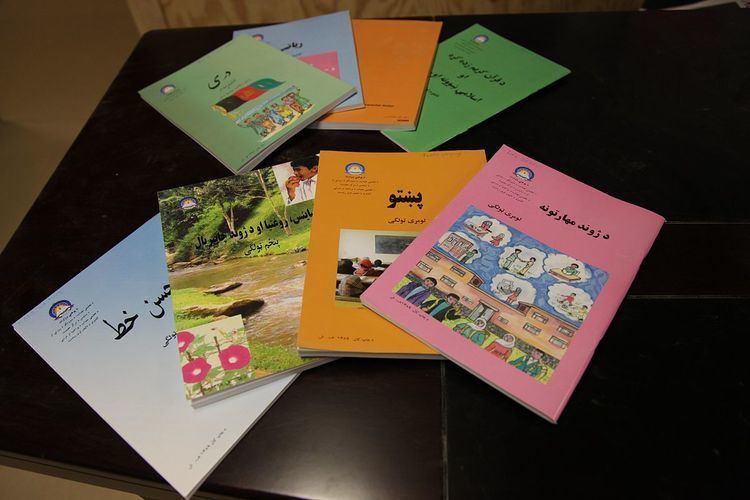 | ||
Pashto dialects (Pashto: د پښتو ګړدودونه da Pax̌to gəṛdoduna) are divided into two varieties, the "hard" northern variety Pax̌to, and the "soft" southern variety Paṣ̌to. Each variety is further divided into a number of dialects. The southern dialect of Wanetsi is the most distinctive of the dialects.
Contents
- Classification
- Literary standard
- Regional standards
- Southern regional standard
- Northern regional standard
- Yusufzai regional standard
- Phonetic differences
- Lexical comparison
- References
The geographic dividing line between the southern and the northern variety passes through the Urozgan, Zabul, and Paktika provinces of Afghanistan, then cuts across the Durand Line border between Afghanistan and Pakistan, and runs further northeastwards to the Kohat and Nowshera districts of the Khyber Pakhtunkhwa province of Pakistan. Hence, the hard Pax̌to is spoken in eastern and northeastern Afghanistan, central, northern, and eastern Khyber Pakhtunkhwa, and northern and central Federally Administered Tribal Areas; while the soft Paṣ̌to is spoken to the south of it, in southern and western Afghanistan, northern Balochistan, southern Khyber Pakhtunkhwa, and southern Federally Administered Tribal Areas. Ethnologue divides Pashto into Northern, Central, and Southern Pashto, and Wanetsi.
Classification
1. Southern variety
2. Northern variety
Literary standard
Literary Pashto, or High Pashto standard, is the standardized variety of Pashto developed by Radio Television Afghanistan and Academy of Sciences of Afghanistan in Kabul. Its phonetics are based on the Central Pashto dialect (also called Northwestern Pashto), which is spoken in the central Ghilji region, but its vocabulary also derives from Southern Pashto. It has adopted neologisms to coin new terms from already existing words or phrases and introduce them into the Pashto lexicon. Educated Standard Pashto is learned in the curriculum that is taught in the primary schools in the country. It is used for written and formal spoken purposes, and in the domains of media and government.
Regional standards
There are several regional standard forms of Pashto which have high prestige, and serve as a means of communication between the various tribal communities in those regions.
Southern regional standard
Southern Pashto, also called Kandahari Pashto, is the prestige variety of Pashto in southern and western Afghanistan, and the Balochistan province of Pakistan.
Northern regional standard
Northern Pashto, also called Eastern Pashto, is the prestige variety of Pashto in eastern and northeastern Afghanistan, and northern part of the Federally Administered Tribal Areas of Pakistan. This dialect is almost identical to Yusufzai Pashto.
Yusufzai regional standard
Yusufzai Pashto, also called Peshawari or Northeastern Pashto, is the prestige variety of Pashto in central, northern, and eastern parts of the Khyber Pakhtunkhwa province of Pakistan.
Phonetic differences
The differences between the standard varieties of Pashto are primarily phonological, and there are simple conversion rules. The morphological differences between the standard varieties are very few and unimportant. Two of the key phonemes whose pronunciation vary between the different Pashto dialects are ښ and ږ. The southern dialect of Kandahar is the most conservative with regards to phonology, because it retains the original pronunciation of these two phonemes as voiceless and voiced retroflex sibilants, respectively, and does not merge them into other phonemes.
However, the dialects spoken by the tribes from the Karlani confederacy of Pashtuns are lexicologically different and very varied. Moreover, the Karlani dialects have a tendency towards a change in the pronunciation of vowels. Depending on the particular dialect, the standard Pashto [a], [ā], [o], [u] may change into [ā], [â/å/o], [ȯ/ȫ/e], [i], respectively. In the Karlani dialects of Waziristan, Bannu, and Tani (southern Khost), which follow the vowel shift to the greatest extent, these four vowels normally change into [ā], [o], [e], [i], respectively.
The nine phonemes represented in the column headings below show key phonetic differences between the dialects. Five of them are consonants written in the Pashto alphabet, and four are vowels written in the Latin script; sounds are transcribed in the IPA:
Lexical comparison
In general, the Karlani dialects, both in southern and northern varieties, show more vocabulary differences than the non-Karlani southern and northern dialects. However, the most distinctive of the Pashto dialects is Wanetsi. Although Wanetsi follows the normal phonetic rules of the southern dialects near it, it is still greatly different from them in lexicon:
Examples of sentences showing the difference between Wanetsi and the regional standard Kandahari:
